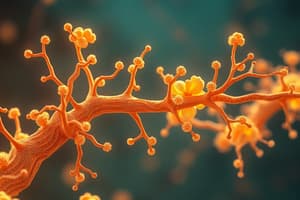Podcast
Questions and Answers
What is the primary action of α1 adrenergic receptors?
What is the primary action of α1 adrenergic receptors?
- Relaxation of the gastrointestinal tract
- Increase in heart rate
- Contraction of blood vessels (correct)
- Inhibition of neurotransmitter release
Which enzyme is responsible for the transformation of noradrenaline into adrenaline?
Which enzyme is responsible for the transformation of noradrenaline into adrenaline?
- DOPA decarboxylase
- Monoamine oxidase
- Phenylethanolamine N-methyl transferase (correct)
- Catechol-O-methyl transferase
Which mechanism primarily facilitates the reuptake of norepinephrine into the presynaptic neuron?
Which mechanism primarily facilitates the reuptake of norepinephrine into the presynaptic neuron?
- Diffusion through membranes
- Uptake 1 (correct)
- Non-exocytosis
- Uptake 2
Which of the following statements about adrenergic receptors is correct?
Which of the following statements about adrenergic receptors is correct?
How is the release of norepinephrine primarily regulated in the synapse?
How is the release of norepinephrine primarily regulated in the synapse?
Flashcards are hidden until you start studying
Study Notes
Adrenergic Transmission
- Noradrenaline (NA) is synthesized in the axon of noradrenergic neurons.
- Tyrosine is converted to DOPA by tyrosine hydroxylase.
- DOPA is converted to dopamine by DOPA decarboxylase.
- Dopamine is converted to noradrenaline by dopamine hydroxylase.
- In the adrenal medulla, noradrenaline is converted to adrenaline by phenylethanolamine N-methyl transferase.
Storage and Release of Noradrenaline
- Noradrenaline is stored with ATP in synaptic vesicles.
- Noradrenaline is released via exocytosis when calcium ions enter the presynaptic neuron.
- Noradrenaline can also be released by non-exocytosis through the action of drugs like amphetamine.
- Auto-inhibitory feedback regulates noradrenaline release. Noradrenaline stimulates α2 receptors in the presynaptic neuron, inhibiting further release.
Elimination of Catecholamines
- Catecholamines (NA, adrenaline, isoprenaline) are eliminated by reuptake and metabolic degradation.
- Reuptake:
- Uptake 1: Noradrenaline is taken up by the presynaptic neuron.
- Uptake 2: Adrenaline is taken up by effector organs like the heart and smooth muscle.
- Metabolism:
- Monoamine oxidase (MAO): degrades catecholamines in the mitochondria of cells.
- Catechol-O-methyl transferase (COMT): found in neuronal and non-neuronal tissues, also degrades catecholamines.
Adrenoceptors
- Adrenoceptors are divided into two classes:
- α receptors: α1 and α2
- β Receptors: β1, β2, and β3
Action of Adrenergic Receptors
- α1 receptors:
- Found in smooth muscle, causing vasoconstriction, GI relaxation, sphincter contraction, and mydriasis (dilation of pupils).
- α2 receptors:
- Found in presynaptic neurons, the CNS, and blood vessels, inhibiting transmitter release and promoting platelet aggregation.
- Postsynaptically, they can function similarly to α1 receptors.
- β1 receptors:
- Found primarily in the heart, increasing contractility and heart rate.
- β2 receptors:
- Found in smooth muscle, causing bronchodilation, peripheral vasodilation, visceral smooth muscle relaxation, skeletal muscle tremor, increased aqueous humor secretion, and increased liver glycogenolysis.
- β3 receptors:
- Their exact functions are not fully understood.
- Adrenaline, noradrenaline, and isoprenaline act on both α and β receptors with varying potencies.
- Noradrenaline preferentially stimulates α receptors, while isoprenaline preferentially stimulates β receptors.
Acetylcholine (ACh) Synthesis
- Choline, taken up from the extracellular fluid, enters the cytoplasm of cholinergic neurons via an energy-dependent carrier system.
- Choline acetyltransferase catalyzes the reaction of choline with acetyl coenzyme A (CoA) to form acetylcholine.
Acetylcholine (ACh) Storage
- Acetylcholine is actively transported into presynaptic vesicles.
- These mature vesicles contain acetylcholine, ATP, and proteoglycans.
- Vesamicol blocks the transport of acetylcholine into synaptic vesicles.
Acetylcholine (ACh) Release
- An action potential triggers the opening of voltage-gated calcium channels at the nerve terminal.
- Calcium influx promotes the fusion of vesicles with the cell membrane, releasing acetylcholine into the synaptic space.
- Botulinum toxin blocks the release of acetylcholine.
Acetylcholine (ACh) Degradation and Recycling
- Acetylcholinesterase rapidly cleaves acetylcholine into choline and acetate in the synaptic cleft, terminating the signal.
- Choline is recaptured by a high-affinity uptake system, transporting it back into the neuron for the synthesis of new acetylcholine.
Acetylcholine (ACh) Receptors:
- There are two major classes of acetylcholine receptors in the parasympathetic system:
- Nicotinic receptors:
- Muscarinic receptors:
Studying That Suits You
Use AI to generate personalized quizzes and flashcards to suit your learning preferences.





